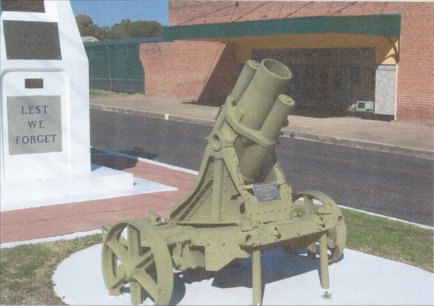
ARTILLERY REGISTER |
|||||||||||||||||||||||
|
|
||||||||||||||||||||||
| Historical Specifics: | The medium mortar was captured by the 17th battalion 1st AIF at Broodseinde on 3 November 1917 and allotted to Werris Creek. The wheels are not original.
It had long been the opinion of the European Armies that the requirement for a mortar was irrelevant in modern warfare. However, the German Army recognised there was still such a need due to lessons learnt from the Russo‑Japanese War of 1904-05, where the Japanese used makeshift weapons to hurl explosive demolition charges to destroy enemy fortifications. Soon after 1910 the medium mortars (or Minenwerfer meaning mine throwers) were introduced as fortification artillery. Following the start of war in 1914 and the commencement of trench warfare they were moved up to the front where they could destroy a whole section of trench and were quite deadly. By 1916 the idea had set in that these mortars were no longer a pioneering tool to smash fortifications, but a weapon intended to support the infantry. During the artillery preparation before a battle their mission was to clear barbed wire, smash enemy trenches or (shallow) dugouts and machine gun positions. When the moment of attack came, they followed the infantry closely to take out any strong points. They could either fire shells that exploded upon impact to clear up barbed wire, or they could fire a shell with a delay fuse. It could also fire gas shells at the enemy, which they did mainly during preparation. The HE shell weighed 50 kg, and the gas shell weighed 40 kg. Barrel length in calibres: 3.8 (a/A) or 4.5 (n/A) |
||||||||||||||||||||||
| General Information on Gun Type: | |||||||||||||||||||||||
| Additional Photos: |
|
||||||||||||||||||||||
